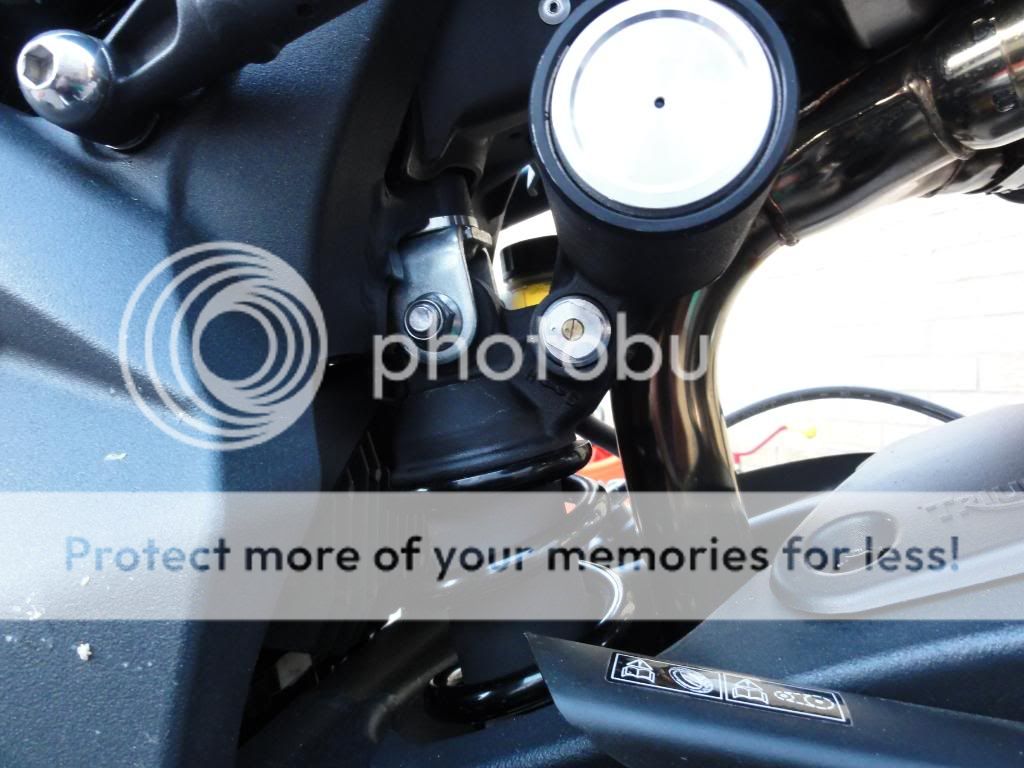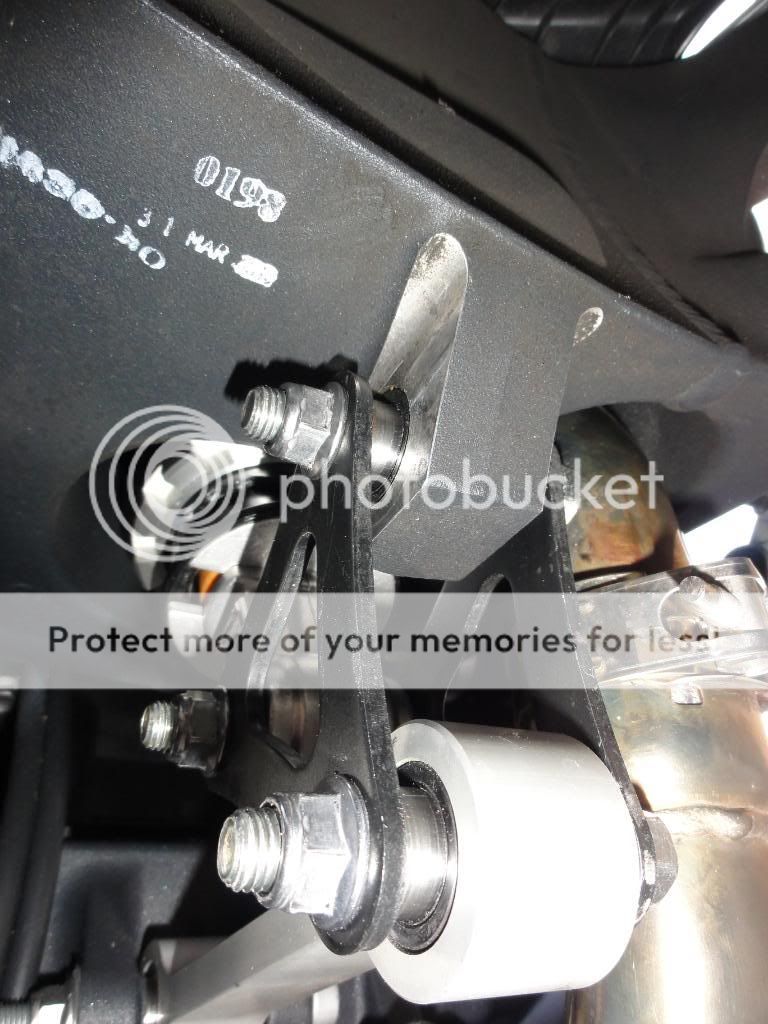Commentary:
I've been doing quite a bit of research on the standard Street Triple's rear shock and upgrade path options that are affordable.
The typical upgrade path seems, for cheap, to be the Daytona model shock. I know there are '06-'08 and '09+ models that are different for the Daytona, and from what I can gather, the differences SHOULD be with the shock itself (spring rate/damping changes) as I gather from Flux's/others threads that the suspension plates are identical across the different Daytona years, and are also identical to both Street Triple models.
I am looking for something different. It seems there are two other possible choices for shock swaps as far as physical fitment goes, being the 07+ CBR600RR and the '09+ YZF-R1. The CBR600RR shock is a verified fit with spacers needed. I canont verify the R1 fitment.
I have read various things about the stock rear shock, some think it is highly oversprung, others think it is highly undersprung. I weigh in at 165 lbs; with gear, maybe another 7-10 lbs or so. I think the stock shock spring rate feels about right, but it still feels harsh over bigger bumps, which makes sense after reading Flux's thread on the curve of the rising rate setup in the rear. On top of that, others have confirmed that the Daytona 675 spring is not a linear spring, but actually progressively wound, by close to a change of 2 kg/mm from beginning to end. We can assume the Street Triple also has a progressively wound spring, then.
These two factors combined are probably the cause for the confusion and mixed feedback. That and Race-Tech's statistics/formula's for these bikes just seems to be wrong (or the level of rising rate in the rear makes it hard to provide a recommendation). So, it probably is undersprung for the first bit of travel (hard to get static/rider sag set), and at the same time, is incredibly harsh after the first bit (much taken up by sag) of travel.
SO, we get to our other options for rear shocks. I don't really want a much higher spring rate, so the Daytona shock is possible, but not preferred. The R1's spring rate is much lower, maybe too low, I don't know because I haven't tried it. I am going to be doing some 2 up riding, so I am going to give the CBR600RR shock a try. They are plentiful and cheap on ebay, and are actually quite a decent unit from shock dyno results and opinions I have read. The length right on the money.
I have read some opinions that the shock is probably a terrible fit because of "totally different spring and damping setups" or whatever; being an OEM shock, the primary concern is the spring rate, and it is about right, compared to our stock shock. The damping is set from the producer according to only the spring rate. The amount of damping is of no concern to the linkage setup; the shock is "oblivious" to the linkage setup. So these comments are simply incorrect.
Thanks to the help of forum members, I was pointed in the direction of a post over on street-triple.co.uk that has some more details on the fitment of the CBR600RR shock. I have added all of the details to this post up to the time of this posting. You can read the full thread here: http://www.street-triple.co.uk/index.php?option=com_smf&Itemid=26&topic=9381.0
Specifications:
Street Triple
The CBR600RR shock upper and lower mounting points aren't the same width (either the top or bottom) as our Street Triple or Daytona counterparts. The top bushing section is 4 mm thinner and the bottom is 9 mm larger. Washers seem to be the easiest solution here. The stock three bolts that are used on the plates that interface the shock, linkage, and frame are 52.5mm long.
Since there looks like there is 5 or so mm or more of extra thread with the stock bolts, 60 mm to 65 mm should work fine. I am using the OEM 62mm bolts for 07+ CBR600RR's ordered from bikebandit.com. Torque these bolts to 33 lb/ft., according to the CBR600RR service manual.
Materials:
Upper Mount:
Well, I recieved the McMaster Carr 4.5mm and 2mm spacers. I've measured both with digital calipers that are accurate to +/- .01mm. Accurate enough for this no question.
Between the four 4.5mm washers, they ranged from 4.53 mm to 4.56 mm, this should be no problem! I can't imagine their range of up to 5.4 mm that they have listed is right, unless my four were from a batch that just happened to be very precise and other batches are way off? I doubt it.
The 2 mm washers varied from 1.88 mm to 2.13 mm. The vast majority were around 2.08 to 2.12 mm, but I picked out a couple in the pack of 50 that were about 1.99 to 2.02 mm depending on where I measured around the diameter of the washer. These should work fine too!
Cost:
Other:
Recommended Initial Settings (165 lb. rider, no gear):
![Image]()
![Image]()
I've been doing quite a bit of research on the standard Street Triple's rear shock and upgrade path options that are affordable.
The typical upgrade path seems, for cheap, to be the Daytona model shock. I know there are '06-'08 and '09+ models that are different for the Daytona, and from what I can gather, the differences SHOULD be with the shock itself (spring rate/damping changes) as I gather from Flux's/others threads that the suspension plates are identical across the different Daytona years, and are also identical to both Street Triple models.
I am looking for something different. It seems there are two other possible choices for shock swaps as far as physical fitment goes, being the 07+ CBR600RR and the '09+ YZF-R1. The CBR600RR shock is a verified fit with spacers needed. I canont verify the R1 fitment.
I have read various things about the stock rear shock, some think it is highly oversprung, others think it is highly undersprung. I weigh in at 165 lbs; with gear, maybe another 7-10 lbs or so. I think the stock shock spring rate feels about right, but it still feels harsh over bigger bumps, which makes sense after reading Flux's thread on the curve of the rising rate setup in the rear. On top of that, others have confirmed that the Daytona 675 spring is not a linear spring, but actually progressively wound, by close to a change of 2 kg/mm from beginning to end. We can assume the Street Triple also has a progressively wound spring, then.
These two factors combined are probably the cause for the confusion and mixed feedback. That and Race-Tech's statistics/formula's for these bikes just seems to be wrong (or the level of rising rate in the rear makes it hard to provide a recommendation). So, it probably is undersprung for the first bit of travel (hard to get static/rider sag set), and at the same time, is incredibly harsh after the first bit (much taken up by sag) of travel.
SO, we get to our other options for rear shocks. I don't really want a much higher spring rate, so the Daytona shock is possible, but not preferred. The R1's spring rate is much lower, maybe too low, I don't know because I haven't tried it. I am going to be doing some 2 up riding, so I am going to give the CBR600RR shock a try. They are plentiful and cheap on ebay, and are actually quite a decent unit from shock dyno results and opinions I have read. The length right on the money.
I have read some opinions that the shock is probably a terrible fit because of "totally different spring and damping setups" or whatever; being an OEM shock, the primary concern is the spring rate, and it is about right, compared to our stock shock. The damping is set from the producer according to only the spring rate. The amount of damping is of no concern to the linkage setup; the shock is "oblivious" to the linkage setup. So these comments are simply incorrect.
Thanks to the help of forum members, I was pointed in the direction of a post over on street-triple.co.uk that has some more details on the fitment of the CBR600RR shock. I have added all of the details to this post up to the time of this posting. You can read the full thread here: http://www.street-triple.co.uk/index.php?option=com_smf&Itemid=26&topic=9381.0
Specifications:
Street Triple
- Shock Length: 289/290 mm (two different sources)
- Spring Rate: 11.28 kg/mm
- Shock Stroke:
- Top Bushing Mount Width: 30 mm
- Bottom Bushing Mount Width: 30 mm
- Weight: 2.81 kg
- Shock Length: 293/295 mm (two different sources)
- Spring Rate: 12.6 kg/mm
- Shock Stroke:
- Top Bushing Mount Width: 30 mm
- Bottom Bushing Mount Width: 30 mm
- Shock Length: 293/295 mm (two different sources)
- Spring Rate: 12.1-12.2 kg/mm (two different sources)
- Shock Stroke:
- Top Bushing Mount Width: 30 mm
- Bottom Bushing Mount Width: 30 mm
- Shock Length: 293 mm
- Spring Rate: 11.00 kg/mm
- Shock Stroke: 60 mm
- Top Bushing Mount Width: 26 mm
- Bottom Bushing Mount Width: 39 mm
- Weight: 2.54 kg
- Shock Length:
- Spring Rate: 10.00 kg/mm
- Shock Stroke:
The CBR600RR shock upper and lower mounting points aren't the same width (either the top or bottom) as our Street Triple or Daytona counterparts. The top bushing section is 4 mm thinner and the bottom is 9 mm larger. Washers seem to be the easiest solution here. The stock three bolts that are used on the plates that interface the shock, linkage, and frame are 52.5mm long.
Since there looks like there is 5 or so mm or more of extra thread with the stock bolts, 60 mm to 65 mm should work fine. I am using the OEM 62mm bolts for 07+ CBR600RR's ordered from bikebandit.com. Torque these bolts to 33 lb/ft., according to the CBR600RR service manual.
Materials:
Upper Mount:
- 2 - 2mm thick M10 washers, mcmaster.com part number 93475A280
- 3 - M10 x 62 x 1.25 mm CBR600RR shock bolts, bikebandit.com part number 721180
- 4 - 4.5 mm thick M10 washers, mcmaster.com part number 94768A106
Well, I recieved the McMaster Carr 4.5mm and 2mm spacers. I've measured both with digital calipers that are accurate to +/- .01mm. Accurate enough for this no question.
Between the four 4.5mm washers, they ranged from 4.53 mm to 4.56 mm, this should be no problem! I can't imagine their range of up to 5.4 mm that they have listed is right, unless my four were from a batch that just happened to be very precise and other batches are way off? I doubt it.
The 2 mm washers varied from 1.88 mm to 2.13 mm. The vast majority were around 2.08 to 2.12 mm, but I picked out a couple in the pack of 50 that were about 1.99 to 2.02 mm depending on where I measured around the diameter of the washer. These should work fine too!
Cost:
- '09 CBR600RR shock - $32.95
- 4 x M10 4.5 mm washer - $20.60
- 50 pack M10 2 mm washer - $4.07
- 3 x M10 x 62 x 1.25 bolts - $9.81 + $8.95 s/h
Other:
Recommended Initial Settings (165 lb. rider, no gear):
- Preload - Setting 4 of 7 for 07/08 shocks, 7 out of 10 for 09+ shocks
- Compression Damping - 20 clicks out
- Rebound Damping - 2 turns out











